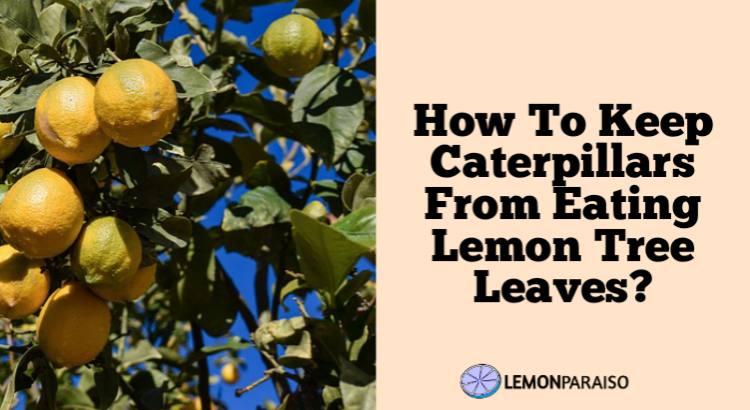How to Keep Caterpillars From Eating Your Lemon Tree Leaves?

Lemon trees are a wonderful addition to any garden or backyard, but unfortunately, they can be a tasty treat for caterpillars. These pesky insects can quickly defoliate a lemon tree, leaving it vulnerable to disease and pests. However, there are several effective methods to keep caterpillars from munching on your lemon tree leaves.
What Kind Of Caterpillar Eats Lemon Tree Leaves?
The type of caterpillar that commonly feasts on lemon tree leaves is the citrus swallowtail caterpillar (Papilio demodocus). These caterpillars are native to regions where citrus trees grow, such as Africa, Asia, and Australia.
They are typically green or brown and have a pattern that camouflages them amongst the leaves. Another caterpillar that targets citrus trees is the citrus leafminer (Phyllocnistis citrella), which leaves serpentine trails on the leaves. Although these caterpillars primarily consume the foliage, they can sometimes cause damage to the tree’s fruit as well.
How Do I Get Rid Of Caterpillars On My Lemon Tree?
To get rid of caterpillars on your lemon tree, you can use several methods. One effective approach is to physically remove the caterpillars by hand or by using a soft brush. You can also introduce natural predators, such as ladybugs or parasitic wasps, to help control the caterpillar population.
Insecticidal soap or neem oil can be applied to the affected leaves, providing a safe and organic solution. Bacillus thuringiensis (Bt), a natural bacterium, can be used as a targeted treatment that is only harmful to caterpillars. Lastly, maintaining proper tree care, such as pruning and adequate water, can help keep your lemon tree healthy and more resistant to infestations.
Are Caterpillars Harmful To Lemon Trees?
Caterpillars can be harmful to lemon trees, as their feeding can cause significant damage to the tree’s foliage. The leaves are essential for photosynthesis, which provides the tree with energy to grow and produce fruit.
In severe infestations, caterpillars can defoliate the tree, leading to reduced fruit yield and a weakened tree more susceptible to diseases and other pests. However, minor infestations are generally not a cause for concern, as lemon trees can recover from the loss of a few leaves. It’s essential to monitor the caterpillar population and take action when necessary to protect your tree.
What Are The Signs Of Caterpillar Damage On Lemon Trees?
The signs of caterpillar damage on lemon trees include visible chew marks on the leaves, with edges or entire sections consumed. Additionally, you may notice the presence of frass, which are caterpillar droppings, near the affected areas.
Caterpillars like the citrus leafminer create serpentine trails on the leaves, which can cause them to curl and distort. Large infestations can result in partial or complete defoliation of the tree. If you spot any of these signs, it’s essential to take action quickly to minimize the damage to your lemon tree.
How Can I Prevent Caterpillars From Eating My Lemon Tree Leaves?
To prevent caterpillars from eating your lemon tree leaves, adopt a combination of preventative measures. Regularly inspect your tree for signs of caterpillars and remove them promptly. Encourage natural predators, such as birds, ladybugs, and parasitic wasps, by providing a suitable habitat or introducing them to your garden.
Utilize physical barriers like tree bands or sticky traps to deter caterpillars from climbing up the tree trunk. Additionally, practice good tree care, including proper pruning, watering, and fertilizing, to maintain your tree’s overall health and resilience against pests.
What Is The Life Cycle Of a Caterpillar That Eats Lemon Tree Leaves?
The life cycle of a caterpillar that eats lemon tree leaves consists of four stages: egg, larva, pupa, and adult. The adult butterfly or moth lays its eggs on the lemon tree leaves, where they hatch into larvae, or caterpillars. The caterpillars feed on the leaves, growing and molting several times before entering the pupal stage.
During this stage, they form a chrysalis or cocoon, where they undergo metamorphosis. Once the transformation is complete, an adult butterfly or moth emerges from the chrysalis or cocoon, ready to reproduce and continue the cycle. The duration of the life cycle varies depending on the species, but it typically takes several weeks to a few months for the process to be completed.
Can I Use Natural Remedies To Control Caterpillars On My Lemon Tree?
Yes, you can use natural remedies to control caterpillars on your lemon tree. One effective method is to mix a solution of water, mild dish soap, and garlic or hot pepper, which can be sprayed on the affected leaves to deter caterpillars.
Neem oil is another natural option that can be applied to the tree, disrupting the life cycle of the caterpillars and preventing further infestation. Diatomaceous earth, a natural abrasive powder, can be sprinkled around the base of the tree to create a barrier that deters caterpillars from climbing. Lastly, encouraging natural predators like ladybugs and parasitic wasps can help keep caterpillar populations in check.
What Are Some Common Predators Of Caterpillars That Eat Lemon Tree Leaves?
Common predators of caterpillars that eat lemon tree leaves include birds, ladybugs, lacewings, and parasitic wasps. Birds, such as chickadees, warblers, and titmice, feed on caterpillars and can help control their populations.
Ladybugs and lacewings are beneficial insects that prey on a variety of pests, including caterpillars. Parasitic wasps lay their eggs inside caterpillars, and the developing larvae consume the host, eventually killing it. Attracting these predators to your garden can provide a natural and effective means of controlling caterpillars on your lemon tree.
How Long Does It Take For A Caterpillar To Eat A Lemon Tree Leaf?
The time it takes for a caterpillar to eat a lemon tree leaf depends on the caterpillar species, its size, and the leaf’s size. Small caterpillars may take several days to consume a leaf, while larger, more voracious species can devour a leaf in a matter of hours.
Additionally, the rate of consumption may increase as the caterpillar grows and its appetite expands. It’s essential to monitor your lemon tree for signs of caterpillar damage and take appropriate action to prevent extensive leaf loss.
Are There Any Specific Types Of Caterpillars That Target Lemon Trees?
Yes, there are specific types of caterpillars that target lemon trees, including the citrus swallowtail caterpillar (Papilio demodocus) and the citrus leafminer (Phyllocnistis citrella). These caterpillars have evolved to thrive on citrus trees, including lemon trees, and can cause significant damage if not controlled.
Both species have distinct feeding habits and can be identified by their appearance and the damage patterns they leave on the tree’s leaves. It’s crucial to identify the type of caterpillar infesting your lemon tree to apply the most effective control methods.



